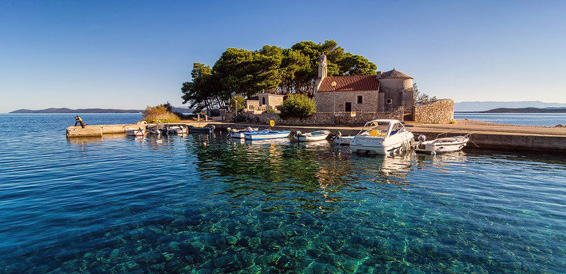
Northern Dalmatia
Northern Dalmatia covers the area between the island of Pag and the town Primosten, behind the Bukovica plateau and Ravni Kotari, under the foothills of the Velebit mountain.
Northern Dalmatia abounds in stunning natural surroundings and impressive historical monuments. Its diverse coastline is bordered by crystal clear sea, scattered with countless islands and bays, large and small, each hiding a unique kind of beauty. Traveling through Northern Dalmatia means following the paths of ancient Romans and arriving at the Forum Romanum in the center of Zadar, following in the trails of Winnetou from Paklenica through the canyon of the Zrmanja river, along the Krka river, and finally setting sail to admire the Kornati archipelago and spend your holidays in untouched nature so hard to come by, yet surrounding you everywhere you go in Croatia.
Over five hundred islands of that area are divided into two archipelagos, one belonging to Zadar and the other to Sibenik. Three national parks and two nature parks are located in the region; Kornati, Krka and Paklenica are the national parks and Telascica and the Vrana Lake are nature parks.
The Kornati National Park is a paragon of beauty stretching 238 km along the coastline, with 89 islands and reefs covering an area of 220 km2. The Kornati archipelago is the favorite destination of sailors and divers alike. Located at the banks of the Krka river, the Krka national park is a refreshing oasis during hot summer months..
Behind its waterfalls, cooled by the forest breeze, lie two impressive historical monuments: the monastery on the island of Visovac and the Krka monastery. The town of Skradin, situated on the right-hand bank of the Krka river shortly before it meets the sea, contributes to the impressive beauty of the area.
The Paklenica National Park is the right place for those who like hiking, hill climbing, speleology or any other adventurous activity. Various caves and pits lie under the canyons of Velika and Mala Paklenica which reach up to 720 m in height and are over 12 km in length.
The Telascica Nature Park is situated next to the Kornati archipelago. This area is very attractive with its cliffs hanging over the sea, often higher than 150 m. The view from the top of the cliffs is breathtaking, showing the open sea and the Mir salt lake, divided from the sea by the thin coastline of the island of Dugi Otok.
The other nature park in the region, the Vrana Lake, is the biggest lake in Croatia reaching its maximum depth at 62 m. With its surface of 57 km2, the park is home to a special orinthological reserve. It is one of the most important reserves of this kind in Europe, with over 241 recorded bird species. One of the highlights of the Vrana Lake Nature Park is an adventurous bicycle track, revealing the lake9s hidden treasures along the 50 km long route.
The wonderful and rich natural surroundings have left their mark on the cuisine of the region. The local chefs are masters at preparing game fish, crab and a variety of molluscs with colorful vegetables and hand-picked spices. Drink a glass of white wine and feel the warmth of the Mediterranean sun. Experiencejust a glimpse of what this paradise has to offer! Unique dishes that stand out and have to be mentioned are skradinski rizoto, a traditional lamb stew slowly and carefully boiled for over 12 hours and sokol, a dry-cured prok neck, first soaked in red wine and then dried in bura, the cold, gusty Croatian northerly wind.
Northern Dalmatia has the most diverse coast in the Adriatic sea. Its many islands and archipelagos hold off big waves coming from the open sea, making sailing enjoyable and relaxing. However, these islands are not high enough to prevent the warm Mediterranean air from entering the area thus resulting in a hot and beautiful climate with less rainfall than in Istria and the Kvarner region. Hot days and surprisingly enjoyable and fresh evenings make it a place of special appeal for spending your holidays.
During the summer, a light to mild maestral is the main wind blowing in the area during the daytime, and in the evening there is a light wind blowing from the north called burin, after its infamous brother. Bura is also present in the area occasionally, mostly during the winter months, however it is significantly weaker compared to the one blowing in the Kvarner area, the Velebit Channel in particular.
Jugo is a relatively strong wind in that region, especially during the winter period, and thanks to the southeast-northwest position of the islands.